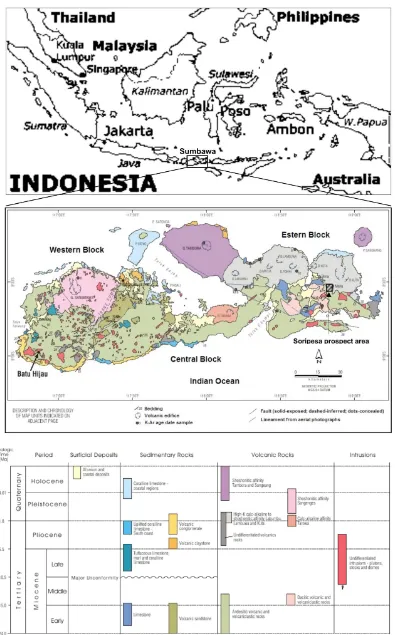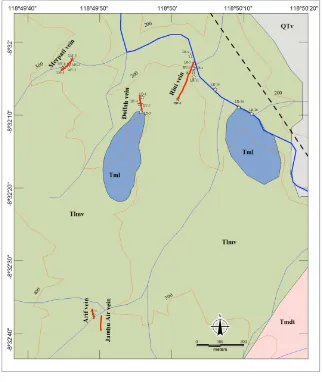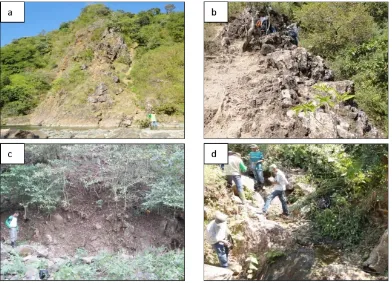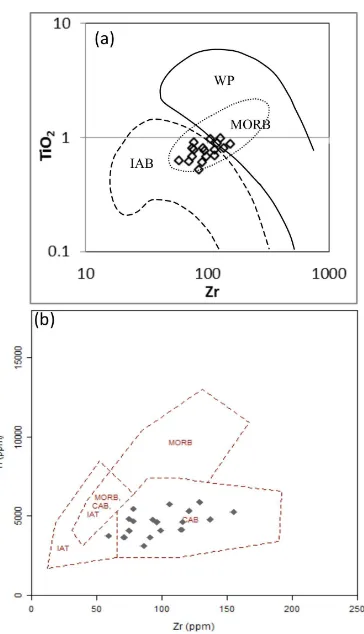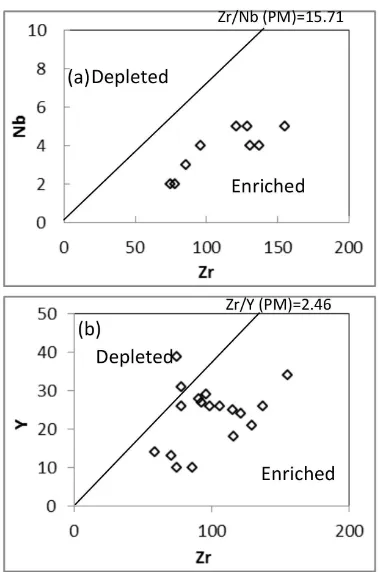HOST ROCKS’ GEOCHEMISTRY AND
MINERALIZATION POTENTIAL OF
POLYMETALLIC EPITHERMAL QUARTZ VEINS
AT SORIPESA PROSPECT AREA, SUMBAWA
ISLAND, INDONESIA
Win Khant∗1,2, I Wayan Warmada2, Arifudin Idrus2, Lucas Donny Setijadji2, and Koichiro Watanabe3
1Department of Geology, Shwebo University, Myanmar
2Department of Geological Engineering, Gadjah Mada University, Indonesia 3Department of Earth Resource Engineering, Kyushu University, Japan
Abstract
The Soripesa prospect area is located at Maria vil-lage, Wawo district, Bima region in the eastern part of Sumbawa Island, Indonesia. This area is a part of Cenozoic Calc-alkaline volcanic inner Banda-Sunda Arc. There are five main polymetallic ep-ithermal quartz veins in the Soripesa prospect area, namely, Rini vein, Jambu air vein, Dollah vein, Mer-pati vein, and Arif vein. The dominant lithology is a lithic-crystal tuff of andesitic and dacitic com-position and bedded limestone. Major oxides and trace elements were analyzed by using X-Ray Flu-orescence (XRF) to identify the host rock geochem-istry. The main veins are hosted by andesitic and an-desitic/basaltic volcanic host rocks. Major elements compositions are affected by alteration. Based on the trace element data, host rocks of all veins were formed in the volcanic arc basalt (VAB) and island arc basalt (IAB) tectonic settings. Host rocks of Rini vein contain higher amount of precious and base metal elements (Zn, Cu, Pb, and Ag.etc.) than those of other host rocks.
Keywords: Soripesa prospect area, lithology, tec-tonic setting, mineralization.
∗Corresponding author: W. KANT, Department of Geological Engineering, Faculty of Engineering, Gadjah Mada University, Jl. Grafika 2 Yogyakarta, 55281, Indone-sia. E-mail: winkhant1995@gmail.com
1 Introduction
The Soripesa prospect area is located at Maria village, Wawo district, Bima regency, West Nusa Tenggara Province, Sumbawa Island, In-donesia. The prospect area is previously owned by PT Bima Baruna Raya Mining (BBRM) and PT Sumbawa Timur Mining. These companies have observed Au-Ag deposit and base metal mineralization. At present, PT Bima Putera Minerals (Indomining Group) has a Mining Permit for those deposits. The prospect area is mainly occupied by andesitic and dacitic vol-caniclastic rocks and small portion of Tertiary bedded limestones. There are five main veins in the Soripesa prospect area including Arif vein, Dollah vein, Jambu Air vein, Merpati vein, and Rini vein, which trend in nearly North-South direction. The main ore minerals are chalcopy-rite, azuchalcopy-rite, malachite, sphalerite and galena forming polymetallic epithermal quartz veins.
pa-per is to confirm the rock types, tectonic setting, and to identify their mineralization potential and the genesis of host rocks of polymetallic ep-ithermal quartz veins in the Soripesa prospect area, East Sumbawa, Indonesia.
2 Tectonic setting and regional geology
The Sumbawa Island forms as a part of the Cenozoic calc-alkaline volcanic inner Sanda– Banda arc which is still active up to present. Sunda–Banda island arc is a volcanic arc formed by the interaction of plate subduction slab in the form of Indo-Autralia with Asian plate. The shape of the island arc is now being modified in the east due to collision with the Australian–New Guinea continental margin, including West Flores to East Sumbawa and Alor (Hamilton, 1979).
The East Sumbawa area is largely under-lain by andesitic to basaltic lava and breccia of the Lower Miocene, with intercalations of tuff and limestone, and fresh pyroclastic sequences (Nana and Aswan, 1978). This sequence is over-lain in parts by dacitic tuff and bedded lime-stone of the Middle Miocene. These units have been intruded by numerous small to medium bodies in the Middle to Upper Miocene includ-ing andesite, dacite, diorite, trachyte and syen-ite (Figure 1). A signature type of epithermal and porphyry copper mineralization can be rec-ognized in those rock units.
The northern part of Sumbawa Island is dom-inated by the eruptive products of the active Tambora and Sangeang volcanoes, comprising of lahar, volcanic bomb and lapilli. Sumbawa Island, regionally, is intersected by NW-SE and NE-SW trending structures. However, the for-mation of quartz veining, alteration and miner-alization at Soripesa Prospect are related to the N-S faulting (Noyaet al., 2009).
3 Geology of prospect area
The Soripesa prospect area is mainly occupied by lava and breccia of andesitic and basaltic composition, intercalation of andesitic tuff and crystalline limestone. It is collectively termed as the Tonggo Formation, (Old Volcanic Rock
Unit) (Noya et al., 2009). It is unconformity overlain by bedded limestone and tuffaceous sandstone of the Lesa Formation (Limestone Unit). Laterally, the Lesa Formation changed gradually into pyroclastic rocks (breccia) with mostly dacitic in composition (Volcanic Rock Unit). It crops out at the southern part of the prospect area. The geological map of the Soripesa area is shown in Figure 2.
Tertiary (lower Miocene) volcanic rock unit (Tlmv)
This rock unit is composed of lava and brec-cia of andesitic and basaltic composition. These rocks are commonly greenish grey, green and violet for the intercalation of tuff (Figure 3a). The rocks are propylitized, mineralized, silici-fied and contain quartz veins. Age and strati-graphic position of the unit are assumed to be the same as the limestone units. In Soripesa prospect area, this rock unit is mainly occurred in central part of the area. Economically, poly-metallic epithermal quartz veins are hosted in this unit.
Tertiary (Miocene) limestone unit (Tml)
In this unit, bedded limestone is the main lithology. The limestone is grey, compact, and some layers contain abundant fossils (Figure 3b). The rocks contain a lot of fauna such as foraminifera, coral, and moluscs. The unit is unconformably underlain by volcanic rocks and laterally changes into coarse pyroclastics and fine pyroclastics. Limestone unit is found in small amount near Soripesa river and cen-tral part of the prospect area. This unit may be formed at early Miocene to middle Miocene (Tertiary) in age.
Tertiary (Miocene) volcanic rock unit (Tmdt)
Figure 2: Geological map of the Soripesa prospect area and surrounding area (modified after Noya
occurred in Western and Southern part of the prospect area.
Quaternary lahar and agglomerate rocks (Qtv)
The intrusive rocks are unconformably over-lain by Quaternary lahar and agglomerate rocks, with basaltic to andesitic in composi-tions. These rocks are product of Maria volcano and are mostly exposed at the northern side of the prospect area (Figure 3d). Recently, Maria volcano is an inactive volcano. This rock unit may not be related with the quartz veins and mineralization in this research area.
4 Mineralization
The main vein zones which are associated with precious metals (Au–Ag) and base metals (Cu, Pb, Zn) are Rini, Jambu Air, Merpati, Arif, and Dollah epithermal quartz veins (Figure 4). They are nearly vertical (>70◦C), 1–16 m thick, with
individual vein up to 1000 m length. The verti-cal outcrop of Rini vein can be observed in the field and it may reach up more than 200 m. The quartz vein and alteration area have a size of 6.7
×4.7 km2or ±3150 hectares (Noyaet al., 2009).
Quartz textures of those veins belong to typ-ical characters of low-sulphidation epithermal system and they can help to identify the mor-phology of veins such as face controlled and parallel-controlled. These parallel-controlled and face-controlled indicate that the epithermal quartz veins in the Soripesa prospect area are formed at the near surface (Khantet al., 2012).
Within the veins, multiphases, vuggy, collo-form, bedded to massive textures with chal-copyrite, galena, sphalerite, malachite, azurite, chalcocite, pyrite, and iron oxide minerals are observed. Weak to moderate clay-pyrite alter-ation is intensively developed in the volcanic rocks, especially in the west side of Soripesa. It could be influenced by NW–SE trending struc-tures and andesite to porphyry dacite intru-sive rock. The common alteration minerals in this prospect area are quartz, epidote, chlorite, pyrite, illite, and smectite. Minor amount of other alteration minerals are kaolinite, alunite, rutile, and anatase (Khant et al., 2012). Tem-perature sensitive minerals include Ca-silicates
such as epidote and chlorite (stable above 200– 240◦C), near the base of the epithermal envi-ronment. At the edges of the quartz veins de-velop silica clay-chlorite alteration; outward, it has changed to chlorite-epidote ± magnetite as the halo alteration.
5 Sampling and analytical methods
Nine host rock samples are selected for X-ray fluorescence analysis. All selected representa-tive samples were collected from the host rocks of polymetallic epithermal veins. Major and trace element data were obtained by XRF analy-sis using a Rigaku RI3100 Serial VR 25006 X-ray fluorescence spectrometer at the Earth Re-sources Engineering Department, Kyushu Uni-versity, Japan. Samples were crushed by vibra-tion mill and heated by electronic furnace about 3 hours to get LOI (Loss of Ignition). Selected 12 samples are sent to Activation Laboratories, Ltd., Canada for analyzing major elements and trace elements composition. The 10 altered an-desite and 2 limestone samples are analyzed by ICP for major element composition and INNA for trace element composition.
6 Results and discussion
6.1 Host rocks’ geochemistry
Geochemical characteristics of host rocks are important to know the classification, their gen-esis, and environments in which they formed. Geochemical study can be used to confirm the rock types, tectonic setting, and to identify their mineralization potential and the genesis of the host rocks of polymetallic epithermal quartz veins. XRF, ICP, INNA analyze methods are used to know the composition of host rocks.
Major elements
Figure 3: (a) Andesitic volcaniclastic rock (b) Fossiliferous limestones (c) Dacitic volcaniclastic rock (d) Quaternary agglomerate rocks.
Figure 5: Volcanic rock classification plot dia-gram ((Na2O+K2O vs SiO2) (after Middlemost, 1994).
other elements’ Al2O3 8.79–17.52; FeO as total iron 1.52–12.07; TiO20.52–1.47; MnO 0.01–0.85; MgO 0.37–9.03; CaO 0.14–19.5; Na2O 0–1.52 and K2O 0.01–3.24. Some host rocks samples such as DV5, RVH, and MV3 increase the con-tent of SiO2because of alteration effect. On the diagram (SiO2–Na2O+K2O), host rocks there-fore are plotted in basalt, andesite, dacite, and rhyolite fields, respectively, based on the vari-ous content of SiO2(Figure 5).
Trace elements
Trace element compositions of the host rocks of all veins are listed in Tables 1, 2, and 3. Ra-tio and index of some trace elements can be used quantitatively to describe the difference in trace elements from different type of host rocks. To some degree, this difference might reflect the degree of magma crystallization as well as source regions. The volcanic rock classification therefore was estimated and identified by using a diagram that contains the incompatible trace elements (Co and Th).
In the Co versus Th diagram (Figure 6), most of the host rocks of all veins are shown in calc-alkaline series and are falling in the fields of basaltic andesite and andesite. The volcanic rock classification was also estimated and
iden-Figure 6: Co vs Th plot diagram showing volcanic rock classification (after Hastie et al., 2007).
tified by using Nb/Y and Zr/Ti plot diagram (Figure 7). In the Nb/Y versus Zr/Ti diagram, the host rocks of quartz veins show high Zr con-tents and are also falling in the fields of basaltic andesite and andesite.
Pearce (1982) has proposed Zr versus TiO2 and Zr versus Ti diagrams to discriminate basalts from mid-oceanic ridge, island arc, and within plate settings. In these diagrams, the host rock samples are plotted in the field of MORB (Figure 8a and 8b). However, the out-lined MORB field overlaps the fields of island arc basalts and within plate basalts. Thus, Cr vs Y plots of host rock samples in the diagram (Figure 8b) can also be treated as to plot both in the IAB and WPB, indicating their transitional nature between the two settings or between MORB. It is also possible that the overlap is due to the involvement of sub-continental lithosphere in magma genesis as pointed out by Watters and Pearce (1987). In the Zr and TiO2 plot diagram, most of rock samples fall into IAB (volcanic arc basalt) and MORB set-ting. But, there is no sample in the MORB field in Figure 8b).
ele-Figure 7: ZrTi vs NbY plot diagram showing volcanic rock classification (after Pearce, 1996).
Figure 8: Binary diagrams for the tectonic set-ting of the volcanic host rocks from the Soripesa prospect area. (a) Zr vs TiO2 (Pearce, 1982) and (b) Cr vs Y (Pearce, 1982). MORB: Mid-Oceanic Ridge Basalt, IAB: Island Arc Basalt, WPB: Within-Plate Basalt, VAB: Volcanic Arc Basalt.
Figure 9: Typical spider diagram patterns for mid-ocean ridge (MORB), oceanic-island (OIB), island-arc basalts and rock samples from this re-search, normalized according to Sun (1980).
ment spider diagrams for andesite and basaltic andesite rocks exhibit generally similar con-formable parallel patterns. Figure 9 shows the spider diagram patterns for typical mid-ocean ridge, island-arc and oceanic-island basalts including samples from Soripesa prospect area. Comparing with three typical spider diagrams of MORB, alkali OIB, and island arc calc-alkaline basalts, spider diagram of the samples from this research resemble with is-land arc calc-alkaline basalts. In the chondrite-normalized spider diagrams, all samples show the negative anomalies in Nb, Sr, P, Ni, Ti and positive anomalies in K, Ba, Rb, and Th. The most persistent feature of the spider diagrams of volcanic-arc basalts is the marked Nb trough, which has been explained in terms of retention of these elements in the source during partial melting (Wilson, 2007).
Figure 10: Plots of Zr versus (a) Nb and (b) Y for volcanic host rocks showing the less mobile na-ture of these elements and illustrating the sen-sitivity of these element ratios to source compo-sition. Primordial mantle ratios after Sun and McDonough (1989).
(Le Roexet al., 1983). The Zr versus Nb plots of volcanic host rocks of all veins suggests their derivation from moderately enriched source.
For the magmatic evolution processes, SiO2 and some of major oxide elements can not be used due to alteration effect. Therefore, in-compatible element Zr is used instead of SiO2. Abundances of compatible elements such as Cr decrease with increasing fractionation as mea-sured by the abundance of an incompatible el-ement such as Zr, whereas the abundances of incompatible elements such as Sr, Zn, and Ba increase continuously with fractionation.
6.2 Mineralization potential based on ore-forming elements
The abundance of ore elements and incompat-ible elements (mineralizing agent) in rocks is one of the important criteria to evaluate the
po-Figure 11: Ore-forming elements compositions of the host rocks.
tential of mineralization: the higher these ele-ments in rocks, the greater the mineral potential (Yongqinget al., 2009). It can be seen clearly that the main ore forming elements are Pb, Cu, and Zn. The order of ore-forming elements abun-dance (ppm) in host rocks of Arif vein is: Pb 216, Zn 799, Cu 97, As 56, Sb 9, Mo 3; in host rocks of Dollah vein: Pb 1768, Zn 1147, Cu 1390, Sb 6, Mo 1, Ag 22; in host rocks of Merpati vein: Pb 78, Zn 406, Cu 76, As 18, W 36, Sb 3, Mo 1, Ag 4, Sn 4, Au 1.28; and host rocks of Rini vein: Pb 1840, Zn 956, Cu 678, As 57, W 49, Sb 2, Mo 1, Ag 4, Sn 4. Figure 11 shows the graph with the content of ore-forming elements of host of quartz veins. These data indicate that galena (gn), sphalerite (sph) and copper oxide and sulphide minerals can be found as com-mon ore minerals in host rocks of polymetal-lic epithermal quartz veins at Soripesa prospect area, Sumbawa island. In limestone units, rock samples (LR-26 and LD-3) have small amount of ore forming elements (ppm) such as Cu 9–11, Pb 11–12 , and Zn 10–14. It indicates that rock samples from limestone units have no effect of mineralization with quartz veins.
7 Conclusion
largely formed by northward subduction of In-dian oceanic crust. Most host rocks of all veins in the Soripesa prospect area are andesitic, dacitic, and andesitic/basaltic volcaniclastic rocks. According to the geochemical data, host rocks of all veins at the Soripesa prospect area are in andesitic and andesitic/basaltic fields. Host rocks therefore may be formed on medium to thicker continental crust above subducting lithosphere. The trace element data (Zr, Y, Cr, and Ti) indicates that most of the vein host rocks formed in volcanic arc basalt (VAB) and island arc basalt (IAB) tectonic set-tings. The Zr versus Nb plots of volcanic host rocks of all veins suggest their derivation from moderately Zr enriched source. Binary plots of Zr and selected trace elements (Rb, Zn, Ba, and Sr) suggest that the host rocks were formed from fractional crystallization processes. Based on the ore forming elements, host rocks of Rini vein is the highest potential mineralization. But, host rocks of Merpati vein contain lesser amount of ore elements and have a lowest potential of mineralization.
Acknowledgement
Firstly, we would like to thank to AUN-SEED.Net/JICA for their financial supporting. Second, we are thankful to Indomining Group for their permission to collect samples and finally, many thanks to Geology Laboratory, Kyushu University, Japan for making analysis.
References
Carlile, J.C. and Mitchell, A.H.G. (1994) Magmatic arcs and associated gold and copper mineraliza-tion in Indonesia. Journal of Geochemical Explo-ration 50. 91–142.
Ewart, E. (1982) The mineralogy and petrology of Tertiary–recent orogenic volcanic rocks with spe-cial reference to the andesite–basaltic composition range. In: Thorpe RS, Ed. Andesites. New York, John Wiley and Sons: 25–87.
Garwin, S. (2002) The Geologic Setting of Intrusion-Related Hydrothermal Systems near the Batu Hi-jau Porphyry Copper-Gold Deposit, Sumbawa, Indonesia. Global Exploration 2002: Integrated Methods for Discovery, Colorado, USA, 9, pp. 333–366.
Irvine, T.N., and Baragar, W.R. (1971) A guide to chemical classification of common volcanic rocks. Can. J. Earth Sci. 8, 523–548.
Le Roex, A.P., Dick, H.J.B., Erlank, A.J., Reid, A.M., Frey, F.A. and Hart, S.R. (1983) Geochemistry, mineralogy and petrogenesis of lavas erupted along the south west Indian ridge between the
Bouvet triple junction and 11 degrees east. J.
Petrol. 24, 267–318.
Le Bas, M.J., Le Maitre, R.W., Streckeisen, A., and Zanettin, B. A. (1986) Chemical classification of volcanic rocks based on the total alkali–silica di-agram. J. Petrol. 27, 745–750.
Hastie, A. R., Kerr, A. C., Pearce, J. A., and Mitchell, S. F. (2007) Classification of altered volcanic is-land arc rocks using immobile trace elements: de-velopment of the Th-Co discrimination diagram. Journal of Petrology, vol.48, pp. 2341–2357. Middlemost, EAK. (1994) Naming materials in the
magma/igneous rocks system. Earth Sci Rev
37:215–224.
Noya, Y., Effendhy, O., Hamdan Z., Abidin, and Pakaya, Y. (2009) Geological background and eco-nomic prospect of the Soripesa deposit, eastern Sumbawa. Proceeding pit IAGI Semarang, 2009. The 38th IAGI annual Convention and Exhibition Semarang, 13-14, October.
Pearce, J.A. (1982) Trace element characteristics of lavas from destructive plate margins, in: Thorpe, R.S. (Ed.), Andesites. Wiley, London, pp. 545–548. Pearce, J. A. (1996) A user’s guide to basalt discrimi-nation diagrams. In: Wyman, D. A. (ed.) Trace El-ement Geochemistry of Volcanic Rocks: Applica-tions for Massive Sulphide Exploration. Geologi-cal Association of Canada, Short Course Notes 12, 79–113.
Sun, S.S. (1980) Lead isotopic study of young vol-canic rocks from mid-ocean ridges, ocean islands and island arcs. Phil Trans R. Soc. Lond. A297, 409–45.
Sun, S.S. and McDonough, W.F. (1989) Chemical and isotopic systematics of oceanic basalts: implica-tions for mantle composition and processes, in: Saunders, A.D., Norry, M.J. (Eds.), Magmatism in the Ocean Basins Geological Society of London Special Publications, 42, pp. 313–345.
Watters, B.R. and Pearce, J.A. (1987) Metavolcanic rocks of the La Ronge Domain in the Churchill Province, Saskatchewan: geochemical evidence for a volcanic arc origin, in: Pharaoh, T.C., Beck-insale, R.D., Richard, D. (Eds.), Geochemistry and Mineralization of Proterozoic Volcanic Suites Ge-ological Society, Special Publications, 33, pp. 167– 182.
